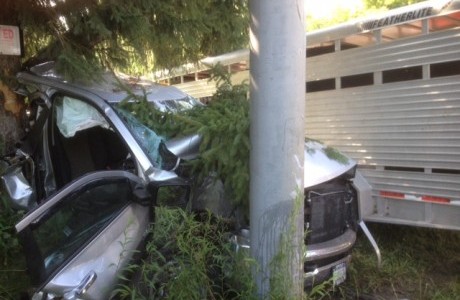
What Happens to a Trailer in a Crash?
When my family was recently in a trailer crash in which all parties were able to walk away (eventually), I knew I had to investigate how everyone stayed safe.
Surprisingly, there’s not a lot of information available over the internet on the physics of horse trailers or trailer collisions. There are pages upon pages of advice about how to teach a horse to load, or best practices for keeping your horse healthy and happy on long-distance hauls, or tips for safety pre-checks of your truck and trailer before you hit the road. There’s lots of advice (mostly from trailer manufacturers) about how to select the best trailer for your needs–based almost entirely on size requirements, ease of use and comfort of the horse while moving. Maybe the idea of getting into a trailer accident with your horses is just too terrible to consider.
And yet when the unthinkable happens — my fiancé and his father were struck by a car on the way back from our annual draft horse fair, with the horses and all of our equipment loaded in the stock trailer — all you really want to know is if your horses are safe. After all, there are no airbags or seat belts back there — just the engineering of the trailer designers working to keep your animals safe in this worst-case scenario.
Remarkably, our Percheron mares walked away from this accident: Their ties had been severed and they both suffered facial lacerations and bruising; Sue had fallen completely to the floor of the trailer while Rose stood over her, and then somehow gotten back to her feet before anyone could get into the trailer to assist her. Other members of our draft horse community hurried to our aid with their own stock trailers and the mares loaded without a fuss to be taken home to meet the veterinarian. My fiancé and his father were hospitalized and later released with treatable injuries. The truck and trailer, despite going through such forces as to jackknife the trailer completely free of the truck, performed their jobs in saving everyone’s lives. Extraordinarily grateful for everyone’s relative safety, I reached out to Featherlite, manufacturers of our (now totaled) stock trailer and asked them how their trailers worked in an accident.
Physics was never my strong suit, so Featherlite’s clear explanation of how the trailer was designed made the entire process much easier for me to understand: Basically, like an automobile, the trailer is built to have certain “crumple zones” which will deform in the case of an accident but continue to be strong and intact in normal use. The crumple zone is the area which is designed to absorb the energy of impact, and generally is built towards the front of the trailer. (Keep this in mind when considering what might happen when a trailer is rear-ended — it’s crucial that drivers understand this and not tail-gate a horse trailer.) If the crumple zone does its job and absorbs the impact, less of that energy is transferred to the cargo — in this case, our horses — as well as the occupants of the tow vehicle.
Crumple zones are achieved in varying ways depending on the kind of trailer — they can be as simple as part of the frame that’s designed to bend or collapse during impact, or as complex as combinations of metal and material engineered specifically to absorb kinetic energy. Featherlite (as I imagine most companies would do) puts individual structures through a thorough testing process which then classifies them according to their energy absorption. This process allows the entire trailer to be built according to what parts need to serve what purpose in a crash.
In this particular accident, the crumple zones did exactly what they were supposed to and kept everyone involved as safe as they were going to be in the kinds of extreme forces acting on the truck and trailer. The impact was strong enough to shear the truck from the trailer without the coupler lock actually disengaging, to give you an idea of what kind of forces I’m talking about. And yet thanks to well-built vehicles, everyone inside lived to tell the tale.
Go Riding.








Leave a Comment